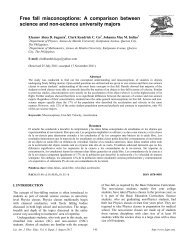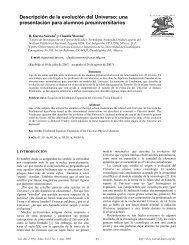Título (usar minúsculas) - lajpe.org
Título (usar minúsculas) - lajpe.org
Título (usar minúsculas) - lajpe.org
You also want an ePaper? Increase the reach of your titles
YUMPU automatically turns print PDFs into web optimized ePapers that Google loves.
Stepan Velychko, Victoria Buzko and Viktor MatsyukNature Studies while teaching Physics in a comprehensive - the knowledge of different subjects is grouped around aschool.particular object (this option can be called modular orprofiled);- being based on really existing objectivity ofІІ. PROBLEM EXAMINATION AT A PRESENT- DAY LEVELknowledge, one subject can comprise the elements ofknowledge and skills in other subjects that are necessary ingeneral and particular cases (basic academic subject isThe problem of forming cognitive interest and the<strong>org</strong>anization of this problem is depicted in the works of L.A. Aristova, H. A. Davydova, V. K. Demydenko, A. M.Matiushkina, N. H. Morozova, M. N. Skatkina, H. I.Shchukina. The works of A. A. Babenko, S. I. Zhmursky,M. T. Martyniuk, N. O. Posternak, I. S. Voytovych, S. V.Horchynsky, T. V. Dubova are devoted to the study ofpupils' interest for some school subjects.placed in the center and concentric circles of approximationof different order accrue around it).The studies of S. P. Velychko [8] prove convincinglythat it is important to form and develop scientific andresearch thinking and make it possible to effectively use itto solve different didactic purposes in physics in secondaryschool in order to prepare a highly qualified teacher whowill be able to implement basic tasks of individuallyA whole range of research by psychologists and oriented technologies while teaching physics. It ispedagogues aims at the study of aspects of a cognitive important to integrate mandatory professionalinterest. The psychological nature of interest is studied in psychological and pedagogical disciplines studied atsome research works (M. F. Bieliayev, L. A. Gordon), the Pedagogical University and to complement them withcognitive interest is viewed as a means of teaching (H. I. additional special courses that are of an integrated natureShchukina, V. B. Bondarevsky), or as a motivation (A. N. both in content and in their procedural component for aLeontiev, S .L. Rubinshtein) in other works.positive solution of this global didactic problem.The questions of pupils' integration of knowledge andUnder the circumstances, an integrated approach toone of the most developed of its levels in particular - special disciplines being created should be combined with:interdisciplinary links - were profoundly highlighted in the 1) the opportunity to get acquainted with the latest scientificworks of well-known methodologists: O. I. Buhayova, S. U. advances in physics, pedagogy and psychology and issuesHoncharenko, I. D. Zvereiev, V. R. Ilchenko, I. M. of methods of teaching physics and to solve complexKozlovska, O. I. Liashenko, V. M. Maksymova, P. I. scientific and methodological problems of differentiatedSamoylenko, O. V. Sergeyev, A. V. Usova, V. M. Fedorova instruction at school simultaneously; 2) the intensificationand many others.of the role of an active individual activity of each student inMethodological and theoretical problems of knowledge developing specific guidelines and in the aspect of hisintegration were examined in the works of S. U. personal development as a future specialist; 3) dealing withHoncharenko, I. M. Kozlovska, P. I. Samoilenko, O. V. contemporary problems of physics methods not only at theSergeyev and others;lectures where the teacher's competence is in no doubt, but- <strong>org</strong>anization of the educational process on the basis of mainly during laboratory practical sessions and whileintegration became the research subject in the scientific carrying out individual tasks, which are based onworks of I. M. Kozlovska, Y. M. Sobko, V. T. Fomenko, T. independent and active cognitive searching activity ofD. Yakymovych and others;students and which simultaneously develop cognitive- the integration of the knowledge in Nature Studies was interest towards the subject under the study and make theanalyzed in the scientific works of Y. I. Dick, V. R. teacher an active and effective practitioner; 4) eachIlchenko, M. T. Martyniuk, V. G. Razumovsky and others;student's possessing the completed materials and works- the principles of interdisciplinary connections and (like: synopses of the lessons, educational activities,professional orientation training were examined in the instructions, etc.) that have previously been discussed andworks by V. M. Maksimova, V. I. Palamarchuk, V. M. evaluated and are allowed to be used during teachingFedorova and others.practice and independent activity) [8, p. 289]. TheThe essence of the integration of training is to combine following samples of such specialized disciplines that wereideas, scientific theories, concepts, teaching technologies by introduced in our pedagogical university and arecoordinating the activity of teachers of different Nature implemented to prepare future teachers of physics forStudies disciplines and cognitive and learning activities of different educational qualifications the following coursesstudents. The idea of integrating content and form of can be considered: for the "bachelor" level — "Modernteaching has always interested scientists and educators who innovative technologies of teaching physics in high school",worked practically. For instance, S. U. Honcharenko and I. for the level of "specialist" — "Using a training laser inM. Kozlovska offer to implement the integration into the teaching the school course of Physics", for the level ofeducational process using several ways:"Master" —"Computer facilities in the educational process- related elements, concepts or actions are selected while teaching Physics."among two subjects and an integrated course is developed;The essence of integration is to obtain a new cognitiveoutcome that has an advantage because of its heuristicsignificance of the cognitive value of all integratedcomponents. The following features of integration shouldLat. Am. J. Phys. Educ. Vol.7, No.2, June 2013 270 http://www.<strong>lajpe</strong>.<strong>org</strong>
e pointed out: 1) the integration is formed as theinteraction of isolated elements, that were previouslyscattered (new conditions that vary in quantity can arouseonly due to different elements); 2) the integration isconnected with qualitative and quantitative transformationsof related items, as a gradual change of separate elementstakes place. The elements are included into an increasingquantity of links, the accumulation of these changes leadsto changes in the structure, the appearance of new functionsof elements, i.e. the nascence of a new integrity; 3) theprocess of integration has its logical and profound basis (theconstruction of integration means, first of all, thedetermination of a common framework for combiningscattered elements of knowledge, the search and reasoningof the criteria of unity of different sets) [9].The objective of this article is to reveal the potential forintegration of knowledge in Nature Studies to formcognitive interest while teaching Physics at school, themain objectives include the possibility to integratetheknowledge in Nature Studies to create and enhancecognitive interest of students by studying the theme"Nucleus. Nuclear energy "(Grade 9).Integration of knowledge of nature studies as a means of forming cognitive interests…- the lesson should deepen and expand the students'outlook;- the lesson should encourage the development of skillswhile studying popular scientific literature, stimulate thestudents' desire to acquire new knowledge independently.It is hard to imagine the modern approach to teachingPhysics without making interdisciplinary connections withother subjects connected with natural sciences. Usinginterdisciplinary connections intensifies the educationalprocess, stimulates students' learning interest, promotes theoutlook expanding. In particular, the links between physics,biology and chemistry that are successfully revealed andshown, reinforce the practical orientation of both a schoolsubject and the educational process in general. Thus,integration aims at laying the foundation for students'holistic understanding of nature and society and formingtheir personal attitude towards the laws of theirdevelopment [11, p. 26].Here are specific examples of the integration of naturalknowledge to create and enhance students' cognitiveinterestfor Physics while studying the theme "Nucleus. Nuclearenergy "(Grade 9).III. IMPLEMENTATION OF INTEGRATIONOF THE KNOWLEDGE OF NATURE STUDIESAS A MEANS OF FORMING COGNITIVEINTEREST WHILE TEACHING PHYSICS INSECONDARY SCHOOLThe term "integration" is derived from Latin integratio —recovery, replenishment, from integer — whole, whichmeans the process and result of interaction betweenelements (with properties given), that are accompanied bythe restoration, establishment, complication andstrengthening of significant ties between them on the basisof sufficient cause, resulting in emerging integrated object(system) with qualitatively new properties, which are storedin the structure properties of individual source elements[10, p. 337]. Methodical basis of an integrated approach tolearning is development of the knowledge about thesurrounding world, establishment of interdisciplinary andintersubject connections while teaching Physics. Thus, weconsider it advisable to call any lesson having its ownstructure an integrated one, if the knowledge, skills andresults of the material analysis that is studied by methods ofother Nature Studies disciplines are applied for itsconduction. Because of it integrated lessons are also calledinterdisciplinary. Such basic didactic requirements towardsan integrated lesson can be pointed out:- the lesson should have a specific educational andcognitive aims that are distinctly formulated;- the lesson should arouse pupils' interest for establishinglinks between adjacent fields of science;- a high activity of students to apply knowledge fromother disciplines (fields of sciences should be provided inthe classroom);Table I. The list of interdisciplinary connections that are used inteaching Physics:Form,ChapterForm 9Nucleus.NuclearEnergySchoolSubjectBiologyChemistryGeographyPhysicsPrimaryschoolNatureStudiesContentsForm 10. Cytoplasm and itscomponentsForm 11. Hypotheses of lifearousing on earthForm 8. The Nucleus Structure:nucleus and electronic shell.The composition of atomicnuclei (protons and neutrons).Proton number. Nucleonnumber. Isotopes (stable andradioactive)Form 8. Major climatic factors:solar radiation, atmosphericcirculation.Form 7. Substance Structure.Form 3. Bodies, substances,particles.Form 5. Bodies and substancessurrounding a man.It is appropriate to use historical information about thescientists who made a significant contribution to thedevelopment of an appropriate direction while teaching thistopic: E. Rutherford, J. Thomson, Maria Sklodowska-Curie,Pierre Curie, N. Bohr and others. It is worth considering theissues of biological effects on the theme "Ionizing radiationeffects". Biochemical changes can occur both in a fewseconds, and in several decades after the exposure andbecome an immediate cause of cell death or the changes init, which can lead to a serious and complicated disease. TheLat. Am. J. Phys. Educ. Vol.7, No.2, June 2013 271 http://www.<strong>lajpe</strong>.<strong>org</strong>
Stepan Velychko, Victoria Buzko and Viktor Matsyukradioactive radiation influences the heredity intensively andaffects the genes in the chromosomes in particular. In mostcases, the effect is adverse.The exposure of living <strong>org</strong>anisms can have some benefitas well. For example, the cells that multiply rapidly inmalignant tumors are more sensitive to radiation thannormal ones. The inhibition of cancer by γ-rays ofradioactive drugs that are more effective for this purposethan X-rays is based on it.Students consider it to be interesting that scientiststhemselves have only recently realized that radon is themost significant of all the natural sources of radiation. It isan invisible, tasteless and odorless heavy gas, which is 7.5times heavier than the air. According to the United Nationsestimates radon and its products of radioactive decaygenerate approximately 3/4 doses of radiation received bythe population from terrestrial sources of radiation. Aperson receives the bulk of the radiation dose from radonwhile being in the rooms that are not ventilated. Then it isadvisable to analyze the diagram concerning the influenceof a room ventilation on the contents of radon in it (Fig. 1).FIGURE 1. The influence of airing the room on the contents ofradon in the air of a bedsitter in a single-family house.It is useful to show the diagram at the Physics lesson, whichis conducted as a conference. It should be noted that thepupils were previously offered to do an individual or groupresearch or mini-projects. The results of pupils' independentresearch can be integrally presented as diagrams, that areillustrated in Figure 2 and 3.μSi/h0,180,160,140,120,180,160,170,14 0,150,14 0,14 0,140,12 0,130,13 0,130,120,10,080,060,040,0201 2 3 4 5 6 7 8 9 10 11 12 13 objectsFIGURE 2. Measuring the equivalent doses of γ-radiation on theschool premises (1 - 8 — classrooms, 9 — Physical Laboratory,10 — the Principal's Office, 11 — Methodical study, 12 —Teachers' Room, 13 — Assembly Hall.μSi/h0,20,180,160,140,120,10,080,060,040,0200,16 0,16 0,18 0,16 0,160,140,160,14 0,150,190,161 2 3 4 5 6 7 8 9 10 11 objectsFIGURE 3. Dosimetric measurements of radioactivity in thecentre of the town (1 — school yard, 2 — Velyka PerspektyvnaStreet (Part I), 3 — Velyka Perspektyvna Street (near the surface),4 — Kirov Square, 5 — Kirov Square (near the surface), 6 —Shevchenko Street, 7 — Bohdan Khmelnytsky Square, 8 — overthe Ingul River, 9 — on the banking (Part I), 10 —on the banking(Part II), 11 — Velyke Perspektyvna Street (Part ІІ).Doing home laboratory assignments in Physics as a meansof developing pupils' cognitive interest, forms the flexibleand critical thinking, observation, increases the interest forPhysics as a science and a school subject.The research of natural radioactivity of food is theexample of the task whose didactic objective is toexperimentally measure the radioactivity of the mostlywide-spread items of food. Such a research develops pupils'cognitive interest for Physics and forms independencewhile carrying research work out. Besides theoreticalinformation, we consider it appropriate to reveal theessence of the concept of background radiation, naturalradioactivity, measured in Bq/kg, radiation of substancesthat enter the human body through food. However, it isappropriate to reveal the possible effects of radioactivity,which influence the human body, getting there by food andrespiratory tracts. Therefore, the ability to explore food'sradioactivity is an important aspect of life.The equipment and materials used in this homelaboratory assignment consist of a dosimeter, buckwheat,instant coffee, milk and other products.Procedure:1. Set the dosimeter on the mode of estimation of volumeactivity of radio nuclides in the samples.2. To measure background activity, then the total activitywith the product under study and to calculate the activity ofthe product.3. To write the results into the table (Table II).4. To draw conclusions.Special attention should be paid, in our opinion, tosolving integrated and interdisciplinary problems. Suchtraining problems in physics with interdisciplinary contentare a source, means and a necessary condition for pupils'interest. If a student has solid knowledge and skills in thefield of Physics, this ability to solve applied problemssignificantly activates his cognitive activity. It is possibledue to the use of interdisciplinary interaction [13, p. 267].Lat. Am. J. Phys. Educ. Vol.7, No.2, June 2013 272 http://www.<strong>lajpe</strong>.<strong>org</strong>
Integration of knowledge of nature studies as a means of forming cognitive interests…Table II. The results of the study of natural radiation of products.№Names of productitemsBackground ActivityАbackActivity MeasurementАmeasProductActivityА=К(Аmeas-Аback)Bq/kgК2=20Кі/kgК1=8·10 -91 Buckwheat2 InstantCoffee3 Milk 30-60Naturalspecificradioactivity(tablemeaning)Bq/ Кі/kgkg60- (1,6-70 1,9)∙10 -9900 2,4∙10 -8(0,8-1,6)∙10 -9Vertically:1. A part of atom that has a positive charge.2. The name of the woman who is one of the founders ofthe radioactivity doctrine and who discovered the influenceof radiation on a living cell. She was the first to useradiation in medicine.4. A French Physicist who was one of the founders of thedoctrine of radioactivity.5. A positively charged particle of a nucleus.6. An uncontrolled conversion of unstable isotopes intoother isotopes, which are accompanied by the emission ofelementary particles.The revision and generalization of the material learnedpreviously, the solution of non-standard creative tasks thatrequire creative thinking are other examples of theintegration of knowledge in the natural sciences. Thefollowing sums can serve as the examples of such tasks:1. To give examples that characterize the quantity andsizes of atoms and molecules:22a) There are 2⋅10drops of water in the Black Sea. There isan equal number of molecules in one water drop.b) A pin head contains more than 10 19 atoms of iron. Ifthese atoms are distributed by one in a row on the way fromthe Earth to the Sun (150 million km), then there will behalf a million atoms on every millimeter of the way [14, p.151].2. The average capacity of an exposure dose of radiationin an X-ray room is−12 Kl6,45⋅10. A doctor spends 5 hourskg ⋅ sa day in this office. What is his dose of radiation in sixweekdays? [15, p. 147].3. Isotope phosphorus-32 is widely used in biology andmedicine. Thus, using the method of tracer atoms, theprocesses of assimilation of nutrients from fertilizer byplants and metabolism in the body are learnt, the growth ofplants' root system is examined. The therapy of blooddiseases is done in medicine. The half-life of phosphorus is14 days, it is a β-radioactive isotope. The maximumradiation energy equals to 1.71 MeV. Define the chemicalelement whose nucleus is formed as a result of the31 31 0following reaction (15P→ 16S+−1e) [16, с. 239].4. Solving crossword-puzzles as a means of raisinginterest for Physics is presented in Fig. 4.Horizontally:3. The tiniest particle of a chemical element that consists ofa nucleus and electrons.7. A chemical element thar was discovered in 1789, it wasobtained in a pure form only in 1841 (the metal of a greysteelcolour).8. The English physicist who offered a nuclear model of anatom.ІV. CONCLUSIONSFIGURE 4. Nuclear Physics.The integration of fundamental and special knowledge inNature Studies promotes: forming generalized andsystemized knowledge, skills and competences in differentschool subjects and corresponding fields of sciences; thecomplex realization of the educational components;forming pupils' general learning skills and competences; thedeeper and more long - lasting acquisition of generalscientific notions in different school subjects; a coordinatedactivity of students and teachers, removing the repetitionand economizing time, keeping the principle of continuityduring the first concentrum of teaching Physics at school.Lat. Am. J. Phys. Educ. Vol.7, No.2, June 2013 273 http://www.<strong>lajpe</strong>.<strong>org</strong>
Stepan Velychko, Victoria Buzko and Viktor MatsyukREFERENCES[1] Dobrynin, N. F., Attention and its Upbringing,(Moscow, 1951), p. 30.[2] Ribo, T., The Psychology of Attention, (Moscow, 1976),p. 208.[3] Rubinstein, S. L., The Grounds of General Psychology,(Peter, St. Petersburg, 2000), p. 712.[4] Morozova, N. G., The Upbringing of Children'sCognitive Interests in the Family, (Moscow, 1961), p. 224.[5] Morozova, N. G., About a Cognitive Interest forTeacher, (Moscow, 1976), p. 46.[6] Kovaliov, A. G., Psychic Peculiarities of a Man:Character, (Leningrad, 1957), p. 263.[7] Petrovsky, A. V., Back to Understanding Personality inPsychology, (Voprosy Psihologiyi,1981), №2, p. 40-46.[8] Velychko, S., On the Experience of Forming andDeveloping Research Thinking of Physics Teachers,(Conference Proceeding “Democracy and Education”. —June 1-2., Kyiv, Ukraine, 2001). Montclair StateUniversity; Kirovograd State Pedagogical University,(Kyiv, 2002), p. 289-294.[9] Tiunnikov, Y. S., Methods of Discovery andDescription of Integrated Processes in Educational Work,(Academy of Pedagogical Sciences, Moscow, 1986), p. 47.[10] Dychkivska, I. M., Innovative PedagogicalTechnologies, (Academy Publishing, Kyiv, 2004), p. 352.[11] Buzko, V. L., Integration of Natural Studies in theProcess of Teaching Molecular Physics in SecondarySchool, Scientific Notes, Issue 2, (Kirovohrad StateTeachers' Training University Publishing, Kirovohrad,2011), p. 202.[12] Shylov, V. F., Laboratory Works at School and atHome: Quantum Physics, (Prosveshcheniye, Moscow,2006), p. 96.[13] Buzko, V. L., Solving Sums as a Means of IntegratingNatural Knowledge while Teaching Physics in SecondarySchool, A Digest of Scientific Works Kamianets-PodilskyNational University, (Kamianets-Podilsky NationalUniversity, 2011), p. 330.[14] Bilimovych, B. F., Physical Quizzes in SecondarySchool, A Manual for Teachers, (Prosveshcheniye,Moscow, 1977), p. 159.[15] Remizov, A. N., A Collection of Sums in Medical andBiological Physics, (Drofa, Moscow, 2001), p. 192.[16] Semke, A. I., Non-Conventional Sums in Physics. Forthe Forms of Natural and Humanitarian Profile, (Academyof Development, Yaroslavl, 2007), p. 320..Lat. Am. J. Phys. Educ. Vol.7, No.2, June 2013 274 http://www.<strong>lajpe</strong>.<strong>org</strong>


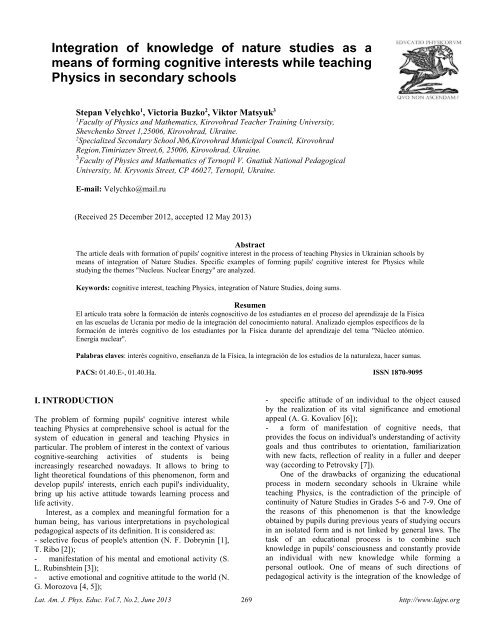
![Diversas formas de visualizar estados en un sistema cuántico [PDF]](https://img.yumpu.com/51151303/1/190x245/diversas-formas-de-visualizar-estados-en-un-sistema-cuantico-pdf.jpg?quality=85)

![Precession and nutation visualized [PDF]](https://img.yumpu.com/50786044/1/190x245/precession-and-nutation-visualized-pdf.jpg?quality=85)
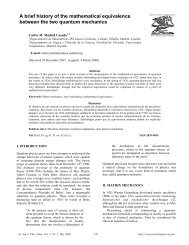
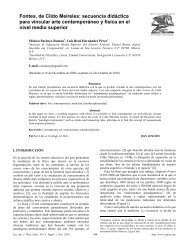
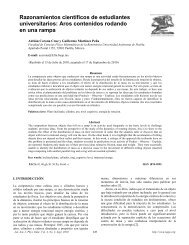

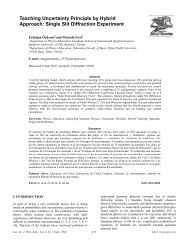
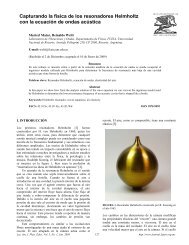
![Index [PDF] - Latin-American Journal of Physics Education](https://img.yumpu.com/47984121/1/190x245/index-pdf-latin-american-journal-of-physics-education.jpg?quality=85)
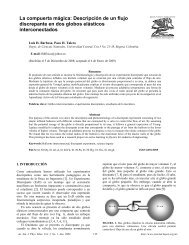
![Flujo de agua en botellas como experimento didáctico [PDF]](https://img.yumpu.com/43536300/1/190x245/flujo-de-agua-en-botellas-como-experimento-didactico-pdf.jpg?quality=85)
